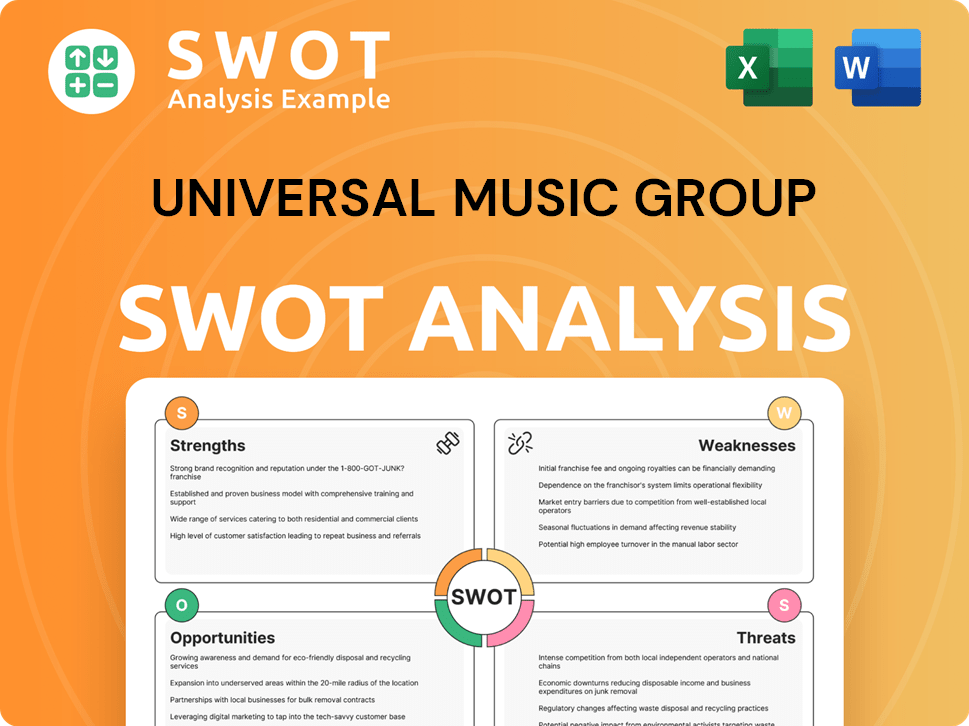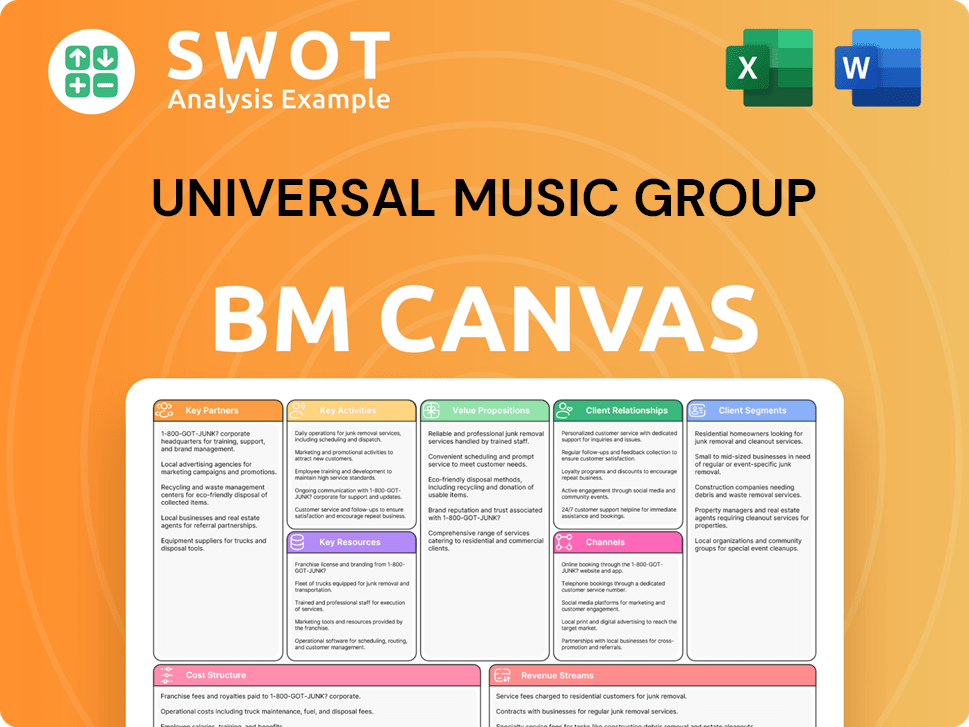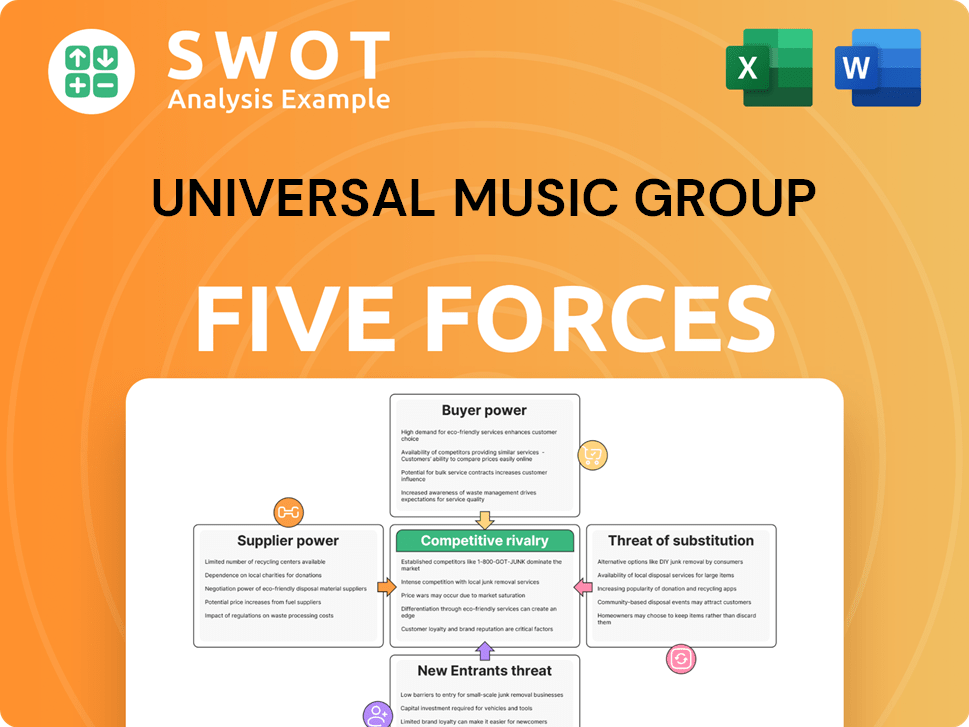Universal Music Group Bundle
How Does Universal Music Group Connect With Its Global Audience?
The music industry is a constantly evolving landscape, and understanding its players requires a deep dive into their customer base. Universal Music Group (UMG), a titan in the music world, has navigated this dynamic environment by strategically identifying and catering to its diverse audience. This exploration delves into the Universal Music Group SWOT Analysis to understand its customer demographics and target market analysis, essential for its continued success.

From understanding who are UMG's main customers to analyzing UMG's target audience age range, this analysis will dissect UMG's approach. We'll uncover UMG's customer demographics by income, the gender split of UMG's audience, and where UMG gets most of its revenue from. Moreover, we'll explore UMG target market geographic location, and how UMG segments its market to understand customer preferences in music genres and their psychographics.
Who Are Universal Music Group’s Main Customers?
Analyzing the customer demographics of Universal Music Group (UMG) reveals a broad, global reach. UMG primarily operates in a Business-to-Consumer (B2C) model, targeting a diverse audience of music listeners. This includes various age groups, from Gen Z, who are early adopters of new platforms, to older generations who engage with established artists and formats. A thorough target market analysis helps understand UMG's diverse consumer base.
UMG's strategy implicitly segments its audience by genre preference, which often correlates with age and cultural background. For example, pop and hip-hop artists frequently resonate with younger demographics, while rock and classical music may appeal to older audiences. UMG's extensive catalog allows it to cater to a wide array of musical tastes, ensuring broad appeal across different consumer segments. Understanding the UMG audience is crucial for effective marketing.
In addition to individual consumers, UMG engages in Business-to-Business (B2B) activities. This involves licensing its catalog to streaming services, film and television production companies, advertising agencies, and video game developers. These B2B customers seek high-quality, legally cleared music content to enhance their products and services. The music industry relies heavily on these licensing agreements for revenue generation.
UMG's primary customers are individual music listeners across various demographics and B2B clients who license music for their products. The consumer base spans different age groups, from Gen Z to older generations, with varying musical preferences. B2B clients include streaming services, film and television companies, advertising agencies, and video game developers.
The target audience includes a wide age range, from young adults (Gen Z) to older generations. Younger demographics often favor pop and hip-hop, while older audiences may prefer rock or classical music. UMG's diverse roster of artists caters to different age groups and musical tastes.
While specific income breakdowns are proprietary, UMG's reach extends across various income levels. The accessibility of music through streaming services and digital platforms allows UMG to reach a broad consumer base. The company's business model is designed to cater to a wide range of consumers.
The gender split of UMG's audience is diverse, reflecting the broad appeal of its artists and music genres. UMG's marketing strategies aim to engage both male and female listeners. The company's diverse artist roster ensures appeal across genders.
The largest share of UMG's revenue comes from recorded music, with streaming being the dominant format. In Q1 2024, recorded music subscription and streaming revenue grew significantly, highlighting the importance of the digital market. UMG segments its market by genre preference, age, and platform usage. This approach allows for targeted marketing and content distribution.
- Streaming Revenue: Streaming continues to be the primary revenue driver, with significant growth in Q1 2024.
- Digital Distribution: UMG has shifted focus to digital distribution, emphasizing digital native consumers.
- Artist Roster: A diverse artist roster caters to various musical tastes and demographic groups.
- B2B Licensing: Licensing to streaming services, film, and advertising contributes significantly to revenue.
Universal Music Group SWOT Analysis
- Complete SWOT Breakdown
- Fully Customizable
- Editable in Excel & Word
- Professional Formatting
- Investor-Ready Format

What Do Universal Music Group’s Customers Want?
Understanding the customer needs and preferences is crucial for success in the music industry. For Universal Music Group (UMG), this involves analyzing the desires of its audience, which influences content creation, marketing, and distribution strategies. This analysis helps UMG tailor its offerings to meet the evolving tastes and expectations of its diverse customer base.
The primary needs of UMG's customers revolve around access to a wide variety of music, the discovery of new artists and genres, and personalized listening experiences. Consumers seek convenience and instant gratification, driving the demand for music across multiple devices and platforms. This focus on customer needs helps UMG maintain its position in the competitive music market.
The decision-making criteria for customers, indirectly choosing UMG's content through streaming services, include the breadth of artists available, sound quality, and the user interface of the chosen platform. Product usage is heavily skewed toward streaming, with subscription services being the dominant consumption method. Loyalty is often tied to specific artists or genres, and the ability of platforms to provide consistent access to preferred content and new releases.
Customers need access to a vast catalog of music. This includes both established artists and emerging talents across various genres.
Consumers seek opportunities to discover new music and artists. This is facilitated through recommendations and curated playlists.
Customers desire personalized music recommendations and curated content. This enhances their engagement with the platform.
Consumers want easy access to music across multiple devices. This includes smartphones, tablets, and smart speakers.
High-quality audio is essential for a satisfying listening experience. This includes lossless audio options.
An intuitive and user-friendly interface is crucial. This ensures ease of navigation and content discovery.
Psychological drivers include the desire to connect with cultural trends and identity through music, the emotional impact of lyrics and melodies, and the social aspect of sharing music. Practical drivers involve the ease of finding and organizing music, and the value proposition of subscription models. UMG addresses pain points such as the difficulty of discovering new music by leveraging algorithmic recommendations through its partnerships with streaming services. Customer feedback, often gleaned from streaming data and social media trends, influences artist development and marketing strategies. For instance, the increasing popularity of certain genres or artists on platforms like TikTok can influence UMG's signing and promotional efforts. UMG tailors marketing by promoting artists across various digital channels, leveraging influencer marketing, and creating engaging visual content to resonate with specific demographic segments. For more insights into the ownership structure and financial performance, consider exploring Owners & Shareholders of Universal Music Group.
Understanding the specific preferences of UMG's target market is critical for effective marketing and content creation. Key areas include:
- Music Genres: Preferences vary widely, from pop and rock to hip-hop and electronic music. Data from 2024 indicates that streaming of Latin music continues to grow significantly.
- Platforms: Customers access music through streaming services like Spotify, Apple Music, and YouTube Music. The platform choice influences the user experience and content discovery.
- Artist Preferences: Loyalty to specific artists and the desire for new releases are major drivers of consumption. UMG leverages this through exclusive content and early access releases.
- Content Formats: Demand for music videos, live performances, and behind-the-scenes content is increasing. This influences how UMG packages and promotes its artists.
- Social Engagement: Customers want to share music and connect with artists and other fans. This drives the use of social media and interactive content.
Universal Music Group PESTLE Analysis
- Covers All 6 PESTLE Categories
- No Research Needed – Save Hours of Work
- Built by Experts, Trusted by Consultants
- Instant Download, Ready to Use
- 100% Editable, Fully Customizable

Where does Universal Music Group operate?
Universal Music Group (UMG) boasts a substantial global footprint, operating in over 60 countries. Its geographical market presence is a critical element of its strategy, enabling it to reach diverse customer demographics worldwide. The company's success hinges on its ability to understand and cater to the varied preferences and purchasing behaviors across different regions.
The United States serves as a cornerstone for UMG, being a major market in the music industry. Additionally, key European markets such as the UK, Germany, and France are crucial for revenue generation and brand recognition. UMG's strategy involves a blend of global reach and localized approaches to maximize its impact in these diverse markets.
UMG has a significant and growing presence in emerging markets across Asia, Latin America, and Africa. These regions are increasingly vital due to their high growth potential and expanding digital adoption. The company strategically adapts its operations and marketing efforts to resonate with local audiences, ensuring sustained growth and market share.
UMG's primary markets include the United States, the UK, Germany, France, and increasingly, countries in Asia, Latin America, and Africa. These markets contribute significantly to UMG's revenue and growth. UMG's presence in these markets is supported by localized operations and strategic partnerships.
To cater to diverse customer demographics, UMG employs localized strategies. This includes signing local artists, developing region-specific marketing campaigns, and partnering with local digital platforms. These efforts help UMG to resonate with local audiences and increase market share. UMG's approach ensures relevance and maximizes its impact in different regions.
UMG is expanding its presence in high-growth regions, especially in Asia. The music market in Asia is rapidly expanding due to increasing disposable incomes and digital adoption. This strategic focus is crucial for future growth. Recent expansions highlight the importance of these regions.
UMG holds a strong market share in its key regions, with significant revenue growth in Latin America and Asia reported in the first quarter of 2024. The geographic distribution of sales increasingly reflects the global nature of music consumption. Digital streaming is a key driver, transcending traditional borders.
Differences in customer demographics, preferences, and buying power across regions necessitate localized strategies. For instance, in emerging markets, mobile-first strategies are essential due to high smartphone penetration. Music preferences also vary, with local artists and genres often dominating. UMG addresses these variations by signing local artists, developing region-specific marketing campaigns, and partnering with local digital platforms and telecommunication companies. For more insights into the competitive landscape, consider exploring the Competitors Landscape of Universal Music Group.
Universal Music Group Business Model Canvas
- Complete 9-Block Business Model Canvas
- Effortlessly Communicate Your Business Strategy
- Investor-Ready BMC Format
- 100% Editable and Customizable
- Clear and Structured Layout

How Does Universal Music Group Win & Keep Customers?
The customer acquisition and retention strategies of Universal Music Group (UMG) are heavily influenced by the dynamics of the music industry. UMG leverages its vast artist roster and extensive content library across various platforms to attract and retain customers. Key marketing efforts are channeled through digital advertising, social media campaigns, influencer marketing, and traditional media, all aimed at reaching the diverse UMG audience.
UMG's approach to customer acquisition and retention centers on the continuous release of new music, the cultivation of artist fanbases, and the provision of a consistent, high-quality listening experience through its partners. Personalized experiences are facilitated by streaming platforms that use algorithms to recommend music based on listening habits. Customer data, primarily aggregated from streaming platform analytics, plays a crucial role in targeting marketing campaigns and informing artist development. CRM systems are used to manage relationships with B2B partners and artists.
The company focuses on driving subscriptions to streaming services, rather than direct sales of individual tracks or albums. This shift reflects a broader trend in the music industry towards digital-first strategies, emphasizing global reach and personalized discovery. This transition has significantly impacted customer loyalty by fostering deeper connections with artists through digital interactions and increasing the lifetime value of listeners.
UMG utilizes digital advertising and social media campaigns to acquire new customers. These campaigns often leverage viral moments on platforms like TikTok and YouTube to rapidly acquire new listeners, thereby expanding its reach. The music industry is highly dependent on these channels for connecting with its target market.
Strategic partnerships with streaming services and social media platforms are crucial for maximizing the reach and visibility of new releases. These collaborations are essential for driving subscriptions and increasing customer engagement. UMG's success is closely tied to its ability to adapt to and leverage these partnerships.
UMG emphasizes artist-driven engagement as a key retention strategy. This includes leveraging artists' social media presence to engage fans directly and promote new releases. The direct connection between artists and fans fosters loyalty and drives continued consumption of UMG content.
Innovative retention initiatives include exclusive content releases and fan engagement events, both virtual and in-person. These efforts deepen customer connections and increase engagement. Such strategies are designed to keep the UMG audience interested and invested in the music ecosystem.
UMG's customer base is diverse, spanning various demographics. The company's revenue is largely derived from streaming, accounting for a significant percentage of its total revenue. The specific geographic locations of UMG's target market are global, with a strong presence in North America, Europe, and Asia.
- Streaming Revenue: Streaming revenues continue to be the primary driver of UMG's revenue, demonstrating the importance of digital platforms.
- Market Segmentation: UMG segments its market based on factors like age, income, and music genre preferences to tailor its marketing efforts effectively.
- Customer Preferences: Customer preferences in music genres vary widely, with pop, hip-hop, and rock consistently being popular.
- Customer Acquisition Cost: The customer acquisition cost varies depending on the marketing channel, with digital campaigns offering relatively efficient acquisition.
Universal Music Group Porter's Five Forces Analysis
- Covers All 5 Competitive Forces in Detail
- Structured for Consultants, Students, and Founders
- 100% Editable in Microsoft Word & Excel
- Instant Digital Download – Use Immediately
- Compatible with Mac & PC – Fully Unlocked

Related Blogs
- What are Mission Vision & Core Values of Universal Music Group Company?
- What is Competitive Landscape of Universal Music Group Company?
- What is Growth Strategy and Future Prospects of Universal Music Group Company?
- How Does Universal Music Group Company Work?
- What is Sales and Marketing Strategy of Universal Music Group Company?
- What is Brief History of Universal Music Group Company?
- Who Owns Universal Music Group Company?
Disclaimer
All information, articles, and product details provided on this website are for general informational and educational purposes only. We do not claim any ownership over, nor do we intend to infringe upon, any trademarks, copyrights, logos, brand names, or other intellectual property mentioned or depicted on this site. Such intellectual property remains the property of its respective owners, and any references here are made solely for identification or informational purposes, without implying any affiliation, endorsement, or partnership.
We make no representations or warranties, express or implied, regarding the accuracy, completeness, or suitability of any content or products presented. Nothing on this website should be construed as legal, tax, investment, financial, medical, or other professional advice. In addition, no part of this site—including articles or product references—constitutes a solicitation, recommendation, endorsement, advertisement, or offer to buy or sell any securities, franchises, or other financial instruments, particularly in jurisdictions where such activity would be unlawful.
All content is of a general nature and may not address the specific circumstances of any individual or entity. It is not a substitute for professional advice or services. Any actions you take based on the information provided here are strictly at your own risk. You accept full responsibility for any decisions or outcomes arising from your use of this website and agree to release us from any liability in connection with your use of, or reliance upon, the content or products found herein.